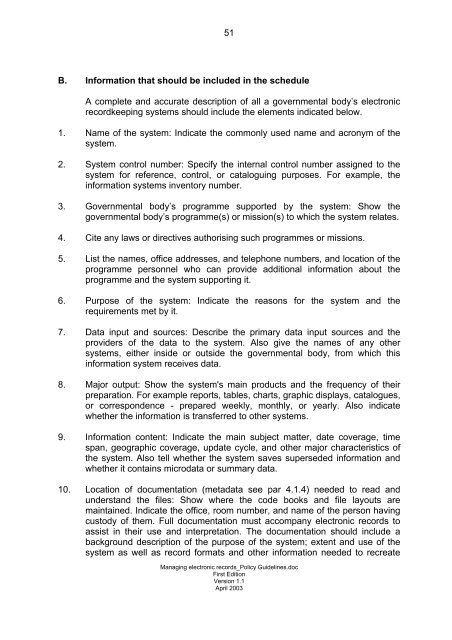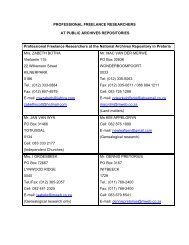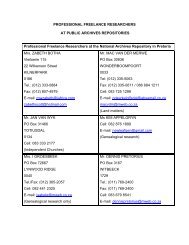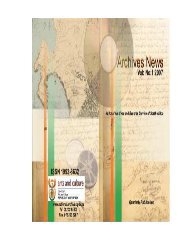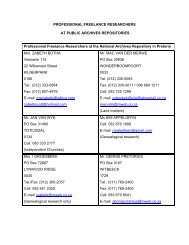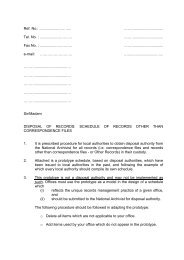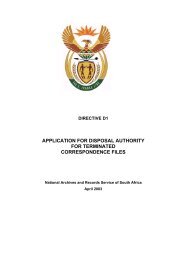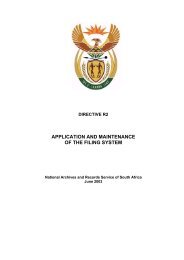managing electronic records in governmental bodies - National ...
managing electronic records in governmental bodies - National ...
managing electronic records in governmental bodies - National ...
You also want an ePaper? Increase the reach of your titles
YUMPU automatically turns print PDFs into web optimized ePapers that Google loves.
51<br />
B. Information that should be <strong>in</strong>cluded <strong>in</strong> the schedule<br />
A complete and accurate description of all a <strong>governmental</strong> body’s <strong>electronic</strong><br />
recordkeep<strong>in</strong>g systems should <strong>in</strong>clude the elements <strong>in</strong>dicated below.<br />
1. Name of the system: Indicate the commonly used name and acronym of the<br />
system.<br />
2. System control number: Specify the <strong>in</strong>ternal control number assigned to the<br />
system for reference, control, or catalogu<strong>in</strong>g purposes. For example, the<br />
<strong>in</strong>formation systems <strong>in</strong>ventory number.<br />
3. Governmental body’s programme supported by the system: Show the<br />
<strong>governmental</strong> body’s programme(s) or mission(s) to which the system relates.<br />
4. Cite any laws or directives authoris<strong>in</strong>g such programmes or missions.<br />
5. List the names, office addresses, and telephone numbers, and location of the<br />
programme personnel who can provide additional <strong>in</strong>formation about the<br />
programme and the system support<strong>in</strong>g it.<br />
6. Purpose of the system: Indicate the reasons for the system and the<br />
requirements met by it.<br />
7. Data <strong>in</strong>put and sources: Describe the primary data <strong>in</strong>put sources and the<br />
providers of the data to the system. Also give the names of any other<br />
systems, either <strong>in</strong>side or outside the <strong>governmental</strong> body, from which this<br />
<strong>in</strong>formation system receives data.<br />
8. Major output: Show the system's ma<strong>in</strong> products and the frequency of their<br />
preparation. For example reports, tables, charts, graphic displays, catalogues,<br />
or correspondence - prepared weekly, monthly, or yearly. Also <strong>in</strong>dicate<br />
whether the <strong>in</strong>formation is transferred to other systems.<br />
9. Information content: Indicate the ma<strong>in</strong> subject matter, date coverage, time<br />
span, geographic coverage, update cycle, and other major characteristics of<br />
the system. Also tell whether the system saves superseded <strong>in</strong>formation and<br />
whether it conta<strong>in</strong>s microdata or summary data.<br />
10. Location of documentation (metadata see par 4.1.4) needed to read and<br />
understand the files: Show where the code books and file layouts are<br />
ma<strong>in</strong>ta<strong>in</strong>ed. Indicate the office, room number, and name of the person hav<strong>in</strong>g<br />
custody of them. Full documentation must accompany <strong>electronic</strong> <strong>records</strong> to<br />
assist <strong>in</strong> their use and <strong>in</strong>terpretation. The documentation should <strong>in</strong>clude a<br />
background description of the purpose of the system; extent and use of the<br />
system as well as record formats and other <strong>in</strong>formation needed to recreate<br />
Manag<strong>in</strong>g <strong>electronic</strong> <strong>records</strong>_Policy Guidel<strong>in</strong>es.doc<br />
First Edition<br />
Version 1.1<br />
April 2003


